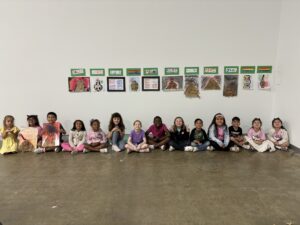
As we wrapped up our first week of Summer Art Camp 2024 in our new space at AMA, we were thrilled to find that the kids’ art projects were closely intertwined with our current exhibition in our traditional gallery space, Pompeii: The Immortal City. Students got to explore the galleries in our Pompeii exhibition, and were guided through by our Director of Education, Vititia Williams. The students not only got to see ancient artifacts, they also made art in response to what they saw and learned.
To gain more insight into camp, we asked the teachers a few questions.
Q: What has been the most rewarding part of camp the first week?
The kids genuinely wanted to be here and showed amazing creativity. As teachers, we learned from each other, and we were flexible.
Q: What was one of your favorite memories from camp?
Hearing parents say that their kids were having a time getting out of bed until they said it was art camp day. The hugs and words of appreciation from parents and students were the best!
All of the crafts that students created allude to Pompeii. The exhibition’s narrative is about how humans interact with the environment and the ‘snapshot’ that humans leave behind. One of the crafts the students made were mache creations that were a mixture of paper, water, and glue. The students modeled a figure of their choice and then got to paint it.
The eruption of Mount Vesuvius being the central point of this tragic event in history, it is important to note the force of nature. The students made multi-media volcanoes. After touring the museum, students used materials such as paper, pastels, markers, shiny Mylar, etc. to show their understanding of what the volcano looked like in Pompeii.
Most Pompeiians were illiterate, and passed down knowledge through word of mouth. We do not have a lot of written information on ancient technology. But because a lot of objects and artifacts were preserved by the gas and ashes, we can learn from what was saved. Or in other words, the imprint humans left behind. For Printmaking, students drew a plan and then carved their print design onto styrofoam sheets, then used water based markers to color their “stamp.” They then used water to activate the color, then made their print.
Vases, also known as amphora, were very essential to the Romans (and Pompeiians). They were used for aging wine, transporting wine in cargo ships, and for holding garum, a fermented fish sauce. The campers made pinch pots with air dry clay and painted them, in reflection to the vessels they saw of Pompeii times. After seeing the different kinds of symmetrical vases during the museum tour, students drew and painted half of the jar onto a folded piece of paper, then rubbed the halves together to create the whole jar. They then used color sticks and texture plates to color their jar and background, then added metallic liquid watercolor for a special end effect.
Creating a learning environment that is embedded in culture and history for the kids was one of the most important factors of summer art camp this year. We asked the kids what they thought about Summer Art Camp this year, these were some of their responses.
I think art camp is the best place because you get to make art and make lots of friends.
- Harlyn
I love art camp because we get to do fun art things and I love Miss Lulu!
- Janielle
Art camp is the best. I really hope I get to go next year!
- Wyatt
I like it because it’s fun and I’ve never done it before but it’s a good opportunity to do art!
- Truly
My favorite part of art camp was we had lots of fun and we worked together and all the colors.
- Hania
I love the art camp because we did a sculpture!
- Martin
About Summer Art Camp at the AMA
Summer Art Camp runs from June 10th through July 1st, and July 19th through August 2nd. If you are interested in signing up for camp this summer, please email our Director of Education, Vititia Williams.
vititia@arlingtonmuseum.org
